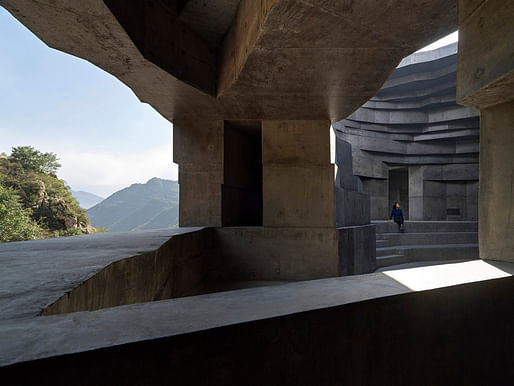
A fascinating addition to the Chinese cultural program has come online this week with the completion of OPEN Architecture’s Chapel of Sound in Chengde, Hebei Province.
Overlooking the ruins of one of China’s most important historic sites, the Ming Dynasty-era Great Wall, the concert hall is made entirely of concrete and enriched with an admixture of minerally-heavy local rocks, encasing a semi-outdoor amphitheater, viewing platform, green room, and outdoor stage. A striated envelope is formed via a series of staggered cantilevers which rise from the rocks below to create an organic-looking profile its designers say is in perfect harmony with the surrounding landscape and sky above.
Inside the building, a slate of winding staircases meanders their way through the structure leading up to the rooftop which offers dynamic views of the valley and the nearby Great Wall.
The building’s form is derived principally from the outsized value the architects placed on acoustics. By studying the effects of sound reverberation in caves and other geological spaces, Beijing-based OPEN was able to draw on its past experiences to engineer an environment that kept sound absorption materials to a minimum with the help of its technology partner Arup.
The overall impact of the building in such an environment was apparent to designers Li Hu and Huang Wenji, who claim they wanted to deliver a structure that was in tune with humanity’s timeless relationship with the natural world.

“We were very aware of the responsibility that we had to contribute a thoughtful structure that fits naturally into such a unique landscape. We wanted to create something different, and more importantly, something meaningful,” both said in a statement. “We are now at a time that the question of our relationship with nature as human beings is more acute than ever. Can we be humble enough to hear what nature is murmuring to us? The symphony of nature is what we really wanted people to experience here.”
“We wanted the definition of the space to be not so absolute, thus allowing for possibilities,” Huang added finally, referring to the building's open-ended form. “Solitary or communal, music or sound of nature, gazing into the starry sky or connecting with one’s inner self.”
No Comments
Block this user
Are you sure you want to block this user and hide all related comments throughout the site?
Archinect
This is your first comment on Archinect. Your comment will be visible once approved.